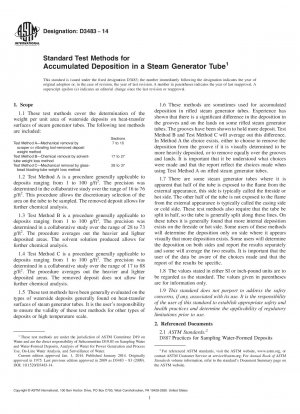ASTM D3483-14
Standard Test Methods for Accumulated Deposition in a Steam Generator Tube
- Standard No.
- ASTM D3483-14
- Release Date
- 2014
- Published By
- American Society for Testing and Materials (ASTM)
- Status
- Replace By
- ASTM D3483-14(2022)
- Latest
- ASTM D3483-14(2022)
- Scope
4.1 The weight per unit area measurement is an indication of the relative cleanliness or dirtiness of the boiler. It is used to determine the effectiveness of the boiler chemical treatment program and to determine the need for chemically cleaning the boiler systems. Allowing the internal deposition to accumulate unchecked will likely lead to boiler tube failures by mechanisms of under deposit corrosion and tube metal overheating.
1.1 These test methods cover the determination of the weight per unit area of waterside deposits on heat-transfer surfaces of steam generator tubes. The following test methods are included:
Sections
Test Method A—Mechanical removal by scraper or vibrating tool-removed deposit weight method
7 to 16
Test Method B—Chemical removal by solvent-tube weight loss method
17 to 27
Test Method C—Mechanical removal by glass-bead blasting-tube weight loss method
28 to 37
1.2 Test Method A is a procedure generally applicable to deposits ranging from 1 to 100 g/ft2. The precision was determined in the collaborative study over the range of 16 to 76 g/ft2. This procedure allows the discretionary selection of the area on the tube to be sampled. The removed deposit allows for further chemical analysis.
1.3 Test Method B is a procedure generally applicable to deposits ranging from 1 to 100 g/ft2. The precision was determined in a collaborative study over the range of 28 to 73 g/ft2. The procedure averages out the heavier and lighter deposited areas. The solvent solution produced allows for further chemical analysis.
1.4 Test Method C is a procedure generally applicable to deposits ranging from 1 to 100 g/ft2. The precision was determined in a collaborative study over the range of 17 to 88 g/ft2. The procedure averages out the heavier and lighter deposited areas. The removed deposit does not allow for further chemical analysis.
1.5 These test methods have been generally evaluated on the types of waterside deposits generally found on heat-transfer surfaces of steam generator tubes. It is the user’s responsibility to ensure the validity of these test methods for other types of deposits or high temperature scale.
1.6 These methods are sometimes used for accumulated deposition in rifled steam generator tubes. Experience has shown that there is a sig......
ASTM D3483-14 Referenced Document
- ASTM D1129 Standard Terminology Relating to Water
- ASTM D1193 Standard Specification for Reagent Water
- ASTM D2777 Standard Practice for Determination of Precision and Bias of Applicable Methods of Committee D-19 on Water
- ASTM D887 Standard Practices for Sampling Water-Formed Deposits
- ASTM G1 Standard Practice for Preparing, Cleaning, and Evaluating Corrosion Test Specimens
ASTM D3483-14 history
- 2022 ASTM D3483-14(2022) Standard Test Methods for Accumulated Deposition in a Steam Generator Tube
- 2014 ASTM D3483-14 Standard Test Methods for Accumulated Deposition in a Steam Generator Tube
- 2005 ASTM D3483-05(2009) Standard Test Methods for Accumulated Deposition in a Steam Generator Tube
- 2005 ASTM D3483-05 Standard Test Methods for Accumulated Deposition in a Steam Generator Tube
- 1983 ASTM D3483-83(2005) Standard Test Methods for Accumulated Deposition in a Steam Generator Tube
- 1983 ASTM D3483-83(1999) Standard Test Methods for Accumulated Deposition in a Steam Generator Tube

Copyright ©2024 All Rights Reserved